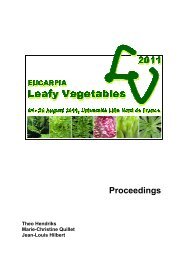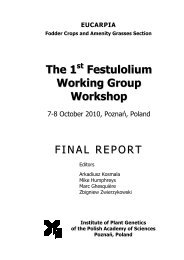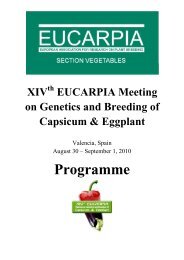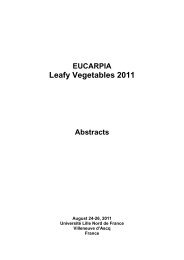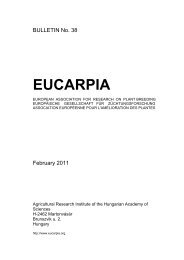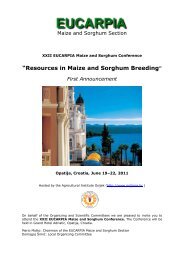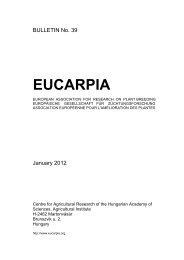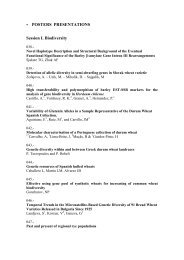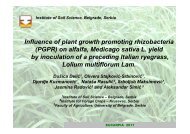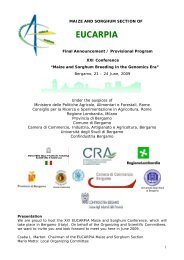Plant breeding for organic and sustainable, low-input agriculture
Plant breeding for organic and sustainable, low-input agriculture
Plant breeding for organic and sustainable, low-input agriculture
Create successful ePaper yourself
Turn your PDF publications into a flip-book with our unique Google optimized e-Paper software.
Developments in <strong>breeding</strong> cereals <strong>for</strong> <strong>organic</strong> farming systems in Europe<br />
Edith T. Lammerts van Bueren 1 , JorgPeter Baresel 2 , Dominique Desclaux 3 , Isabelle<br />
Goldringer 4 , Steven Hoad 5 , Geza Kovacs 6 , Franziska Löschenberger 7 , Thomas Miedaner 8 ,<br />
Hanne Østergård 9 , Martin Wolfe 10<br />
1 Wageningen University, <strong>Plant</strong> Sciences Group, Wageningen, The Netherl<strong>and</strong>s; 2 Technical<br />
University, München-Weihenstephan, Freising, Germany; 3 INRA - UMR Diversité et Génome<br />
des <strong>Plant</strong>es Cultivées, Mauguio, France; 4 INRA - UMR de Génétique Végétale - INRA UPS<br />
INA-PG CNRS, Gif sur Yvette, France; 5 SAC, Edinburgh, Scotl<strong>and</strong>, UK; 6 Agricultural<br />
Research Institute of the Hungarian Academy of Sciences, Brunszvik, Hungary; 7 Saatzucht<br />
Donau GesmbH & CoKG, Probstdorf, Austria; 8 University of Hohenheim,<br />
L<strong>and</strong>essaatzuchtanstalt, State <strong>Plant</strong> Breeding Institute, Stuttgart, Germany; 9 Risø National<br />
Laboratory, Biosystems Department, Roskilde, Denmark; 10 Elm Farm Research Centre,<br />
Wakelyns Agro<strong>for</strong>estry, Fressingfield, Eye Suffolk, UK.<br />
To deal with the rapidly increasing range of environmental diversity, caused by declining oilbased<br />
support <strong>for</strong> agricultural systems together with global climate change, we will need a<br />
tremendous increase in crop <strong>and</strong> livestock diversity. There<strong>for</strong>e the current framework of cereal<br />
pedigree line <strong>breeding</strong> focussed on large scale production of rapidly diminishing genetic<br />
diversity will be increasingly inappropriate in the future. Organic farming systems are holistic<br />
systems according to the concept of naturalness, including the non-chemical approach, agroecological<br />
approach <strong>and</strong> the integrity of life approach. Such systems are necessarily adapted to (a<br />
wide diversity of) their localities. This requires there<strong>for</strong>e a fine-grained adaptation of the crop<br />
plants used on individual farms. We argue that there is a need <strong>for</strong> more <strong>breeding</strong> activities to<br />
improve the <strong>organic</strong> farming systems <strong>and</strong> <strong>organic</strong> product quality. Within the <strong>organic</strong> sector we<br />
distinguish roughly three farming systems: a) global commodity farming, b) regional market<br />
farming <strong>and</strong> c) local market farming systems, each dem<strong>and</strong>ing different kind of variety<br />
requirements. We also distinguish two type of <strong>breeding</strong> programmes: conventional <strong>breeding</strong> <strong>for</strong><br />
<strong>organic</strong> <strong>agriculture</strong> (BFOA) including testing of advanced lines under <strong>organic</strong> conditions in later<br />
stages of <strong>breeding</strong> program, <strong>and</strong> <strong>organic</strong> <strong>breeding</strong> programs (OBP) where all steps in the<br />
<strong>breeding</strong> process are taken under <strong>organic</strong> conditions, <strong>and</strong> including <strong>breeding</strong> techniques that<br />
apply with the <strong>organic</strong> principles. Developing a holistic approach to <strong>breeding</strong> individual cereal<br />
crops dem<strong>and</strong>s a different set of <strong>breeding</strong> objectives with respect to soil, weed, pest, disease <strong>and</strong><br />
quality management, <strong>and</strong> a different set of methods dealing with questions such as wide versus<br />
specific adaptation, the structure of varieties (pure line, mixtures, composite cross populations),<br />
the choice of selection environment, <strong>and</strong> participatory approaches. We will discuss the state of<br />
the art of current approaches <strong>and</strong> research, <strong>and</strong> will end up with recommendations <strong>for</strong> further<br />
<strong>breeding</strong> research <strong>and</strong> programs. A summary table is produced indicating the general<br />
characteristics of <strong>breeding</strong> trends <strong>for</strong> a continuous range of <strong>organic</strong> farming systems.<br />
Acknowledgement: This work was supported by COST Action 860 „SUSVAR” within<br />
Working Group 1 Breeding <strong>and</strong> Genetics<br />
4




